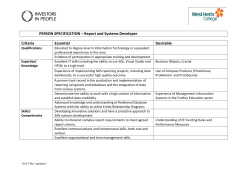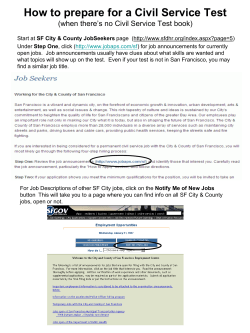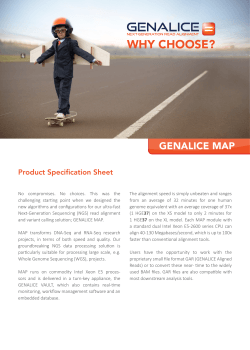
AS and A-level Art and Design A companion guide to our new specifications
AS and A-level Art and Design A companion guide to our new specifications Find out more at: aqa.org.uk/art-and-design New AS and A-levels Our response to change A-levels are changing across the board, with government introducing new regulations about subject content and assessment. When change comes you can ignore it, live with it or embrace it. We decided to embrace it, seizing this chance to listen and learn before acting to produce best in class qualifications. What the changes mean for you All subjects are moving from modular to linear assessment, with exams at the end of a two-year A-level course. The AS becomes a stand-alone qualification, which doesn’t contribute to the A-level grade. Faced with change, we’ve taken a fresh look at our qualifications, working with teachers, universities and others to raise the bar. We’ve refreshed and updated our offer, building on the best of what went before. With the needs of teachers front of mind, we’re making the move to the new specifications as simple as possible. What this means for Art and Design Whatever you think of the changes, for Art and Design we’ve maintained the standard set by our previous specifications. We’ve refreshed the content, developed new resources and continued to expand our comprehensive support service to help ensure that your students receive the results they deserve. Read the specification: aqa.org.uk/art-and-design Speak to us: call 01483 437 750 or email art@aqa.org.uk Find out more about changes to A-levels: aqa.org.uk/alevelchanges AS and A-level Art and Design: key dates Turning new rules into classroom inspiration As an education charity and the largest provider of qualifications in England and Wales, meeting the needs of teachers and students is central to what we do. Great teaching brings every subject to life and our new specifications are designed to support you in the classroom with updated content, resources and support. But we couldn’t do this on our own. Listening The Government and the regulator told us the new rules. We listened to be clear about what was needed. Working together Through workshops, seminars, surveys and conferences, we worked with thousands of teachers across all subjects. We wanted to know what you needed – not guess what you might want. Your views, hopes and aspirations have been crucial in developing our new specifications. October 2014 Launch events: face-to-face and online September 2015 First teaching of new AS and A-level courses Learning lessons Summer 2016 First examinations for new AS qualifications Summer 2017 First examinations for new A-level qualifications With insights and ideas from so many teachers, we paid attention and refined our new specifications to ensure we hit the mark. 2 Taking to the road With two double decker buses we visited 24 locations, meeting teachers from 274 schools and colleges. These teachers came on board to give us more feedback on our draft specifications and materials. Building support While the views of teachers have been crucial, we’ve also worked with universities, subject associations and others. This ensured that our new specifications have the content, credibility and rigour to support your students into the next stage of their lives, whether in higher education or employment. Creating something new Now we have created new specifications, support and resources that will inspire learning and help to realise potential. See how we’re supporting teachers through the changes to A-levels at Exam change essentials: examchange.org.uk 3 AS and A-level Art and Design What’s changed and what’s stayed the same Teachers have chosen our AS and A-level Art and Design in great numbers over the years, making our specifications the most popular of those available. So while government has changed some rules and regulations, we’ve worked with teachers and universities to ensure our new specifications continue to offer a great experience and preparation for higher study or work. We’ve kept the most valued and popular areas of our previous specifications, refreshing the content where needed and enhancing our support service. Assessment changes At AS, we have included artist references in the AS papers because you told us this is what you wanted. Refreshed options Whatever path your students take we want to let creativity flourish, which means being as flexible as possible in what we offer. New options include multimedia, interactive media and games, branding and fashion photography. Enhanced support Teachers like the support we offer but for the new specifications we have worked with teachers to develop our support service even further. We’ve enhanced the role of our subject advisers, we will offer twilight meetings and our helpful and experienced subject team will always be on hand to help. We are also enhancing the subject community to include an area dedicated to universities and art colleges. The bottom line? Teachers have inspired some great work with AQA’s Art and Design qualifications. Our new AS and A-level specifications will enable that great work to continue. Our aim is to make sure we meet teachers’ needs Linda Wakeling is Qualifications Developer for our Art and Design A-levels. A former graphic designer herself, Linda has worked for AQA for 18 years and has seen many changes during that time. But one thing that hasn’t changed is her love and enthusiasm for the subject and a determination to provide the best qualifications and service possible. “While we didn’t choose to make changes to our qualifications, we have used them as an opportunity to improve. This has given us a chance to review our offer, consult with teachers and higher education, and refresh the content to ensure we’re up to date. “I’m very excited about our new specifications and feel confident that the choice and range of options will motivate teachers and give students the opportunity to produce some great work. “Our qualifications are very popular and our aim throughout this development process has been to make sure that we meet teachers’ needs. For this reason we are retaining the popular face-toface teacher standardisation meetings – more than 40 of them – and will continue to visit schools and colleges to carry out moderation. “Unlike other exam boards, we always exhibit students’ original work at these meetings, not just a PowerPoint, as 4 Linda Wakeling, Qualifications Developer it gives teachers a real feel for the standard of work produced, how it is assessed, the scale, texture, subtlety of colour, line tone, form and material. “Through these meetings we help to facilitate a network of teachers who build links and keep in touch with each other. With our new specification we’ll also be forging stronger links with higher education, which I’m sure will be welcomed by teachers.” 5 Why choose our new AS and A-level Art and Design specifications? Creative and inspirational teachers choose our specifications for a variety of reasons 1 Great support From lesson plans to exemplar material you’ll be in safe hands, backed by an extensive programme of support meetings to help you teach the specifications and mark work. You will benefit from free of charge teacher twilight sessions hosted by senior examiners as well as CPD from our experts. 2 Insights into assessment We host more than 40 free standardisation meetings throughout the country, using live student work across all titles to give you insights into the national standard and exhibit different approaches to delivery. We’ll give you a Teacher’s guide with updated information on how to interpret the assessment objectives as well as advice on managing the externally set assignments for A-level, guidance on researching and developing ideas, contextual and critical work, presenting work, the use of sketchbooks, journals and workbooks. 6 3 A truly personal service When you teach our specifications we provide each school or college with a dedicated subject adviser who you can speak to for one-to-one advice on planning, teaching, assessment or whatever you need. Each of our advisers is an experienced teacher and assessor and will be allocated to you based on the endorsement titles you offer. 4 5 Creative freedom You can create courses that play to your school or college’s strengths, while your students can choose an area of personal interest and submit any work providing it meets the assessment criteria. They have freedom to interpret, create and express themselves. 6 Evolution not revolution Whether you already teach with us or are moving from another exam board, you’ll find a lot that’s familiar. We’ve retained the most valued areas of our previous specifications, updating the content and using a similar structure and assessment methods to GCSE. With our help, the move to the new specifications should be trouble-free. Co-teachability of AS and A-level Our AS and A-level are co-teachable so you’ll be able to teach and inspire a mixed class of AS and year one A-level students if you choose to do so. This will help with resourcing and timetabling, giving AS students the chance to progress onto the full A-level if they wish. 7 What’s in the specifications? How are they assessed? We’ve worked with teachers to develop specifications that aim to inspire, motivate and enable creativity to flourish. Assessment The four assessment objectives set by Ofqual are very similar to those you have been working to before now. They are: AO1: Develop ideas through sustained and focused investigations informed by contextual and other sources, demonstrating analytical and critical understanding. AO2: Explore and select appropriate resources, media, materials, techniques and processes, reviewing and refining ideas as work develops. AO3: Record ideas, observations and insights relevant to intentions, reflecting critically on work and progress. AO4: Present a personal and meaningful response that realises intentions and, where appropriate, makes connections between visual and other elements. Component 1 (AS level only) The portfolio has no time limit and is worth 60% of the marks. It comprises the first part of the AS. Students choose one of the six titles available and work on this throughout the course. Students develop work based on an idea, issue, concept or theme leading to a final outcome or a series of related outcomes. 8 Component 2 (AS level only) This is an assignment that we set, worth 40% of the AS-level; we’ll provide you with the question papers in January for distribution to students at the start of February. Each endorsement title will have its own paper with a choice of five questions to be used as starting points; your students will have to choose one. Students have 10 hours of supervised time. You are free to timetable the 10 hours however you like, provided the first 3 hours are consecutive. Students must produce a finished outcome or a series of related finished outcomes in the 10 hours. Component 1 (A-level only) This personal investigation consists of coursework with no time limit and is worth 60% of the marks. Students choose one of the six titles available and work on this throughout the course. Students develop work based on an idea, issue, concept or a series of related outcomes. It must be supported by written work of between 1,000 and 3,000 words. Component 2 (A-level only) This is an assignment that we set, worth 40% of the A-level; we’ll provide you with the question papers in January for distribution to students at the start of February. Each endorsement title will have its own paper with a choice of eight questions to be used as starting points; your students will have to choose one. Students have 15 hours of supervised time. You are free to timetable the 15 hours however you like, provided the first 3 hours are consecutive. Students must produce a finished outcome or a series of related finished outcomes in the 15 hours. Subject content Like our previous specifications, we have six titles and your students must choose one of these. Your students can then take any creative path within the title they choose. •Art, craft and design This is a broad-based course exploring practical and critical/contextual work through a range of 2D and/or 3D processes and media associated with two or more of the other titles shown here. •Fine art Students should produce practical and critical/contextual work in one or more areas, including drawing, painting, mixed media, sculpture, ceramics, installation, printmaking, moving image and photography. •Graphic communication Students should produce practical and critical/contextual work in one or more areas, including web and app design, interactive media, advertising, packaging design, design for print, illustration, communication graphics, branding, multimedia, motion graphics, design for film and television. •Textile design Students should produce practical and critical/contextual work in one or more areas, including fashion design, fashion textiles, costume design, digital textiles, printed and/or dyed fabrics and materials, domestic textiles, interior design, constructed textiles, art textiles and installed textiles. •Three-dimensional design Students should produce practical and critical/contextual work in one or more areas, including ceramics, sculpture, jewellery, exhibition design, design for theatre, television and film, interior design, product design, environmental design, architectural design, body ornament and 3D digital design. •Photography Students should produce practical and critical/contextual work in one or more areas, including portraiture, landscape photography, stilllife photography, documentary photography, fashion photography, experimental imagery, multimedia, photojournalism, photographic installation and moving image. For both AS and A-level we encourage students to develop: •an appreciation of primary sources and critical appreciation of secondary sources •an understanding of issues, themes and concepts that inspire practice •an understanding of the properties of different media and materials •a range of techniques and processes •their own strengths in the subject and identify and sustain their own lines of enquiry. Read the full specification at aqa.org.uk/art-and-design 9 The results your students deserve Assessment you can trust You want to be confident that your students will receive the marks they deserve – and that’s our priority too. Helping you to manage assessment All of our AS and A-level Art and Design will continue to be marked by you with moderation conducted by our experienced, well-trained moderators. We visit all schools and colleges and go to great lengths to ensure consistency, reliability and fairness when assessing work. Your passion and expertise will inspire your students with a love for Art and Design. But we don’t just leave you to get on with it. You’ll have a dedicated subject adviser who you can turn to as little or as often as you like for advice on assessment or whatever you need. Backed by your Teacher’s guide and our knowledgeable subject team, you’ll have assessment covered. Standardisation meetings Understanding assessment We are open and honest about the way assessment works and will stage more than 40 free face-to-face standardisation meetings throughout the country. These highlight how work is marked, and unlike other exam boards they always feature an exhibition of student work, not just PowerPoint slides. To show exactly how we award grades and give you a better understanding of how assessment works, we’ve produced a short animated film. You’ll find that these meetings will give you a great feel for the standard of work and you’ll benefit from the networking opportunities with colleagues from other schools and colleges. •You can analyse your students’ results with Enhanced Results Analysis (ERA), our free online results analysis tool. Register at aqa.org.uk/era 10 •Visit aqa.org.uk/explainingassessment to see our Explaining assessment and How a specification is created videos •For information about results, including grade boundaries and our post-results services, visit aqa.org.uk/results Resources and a support service to support great teaching Art and Design teachers are often the most dedicated and creative in any staff room and we know your ability to track down new resources to help teaching and learning. But when a new specification is introduced, you’ll want to know what support you’ll receive to help the transition. For this reason, we’ve produced new resources and strengthened our support to help you deliver inspiring lessons. These include: •good practice exemplars, to illustrate the standard mapped to the new assessment objectives with examiner commentary •revised schemes of work across all titles to help you plan your course with confidence •a summary of changes •advice on interpreting the assessment objectives •guidance on managing externally set assignments •portfolio and personal investigation guidance to help you plan, teach and assess student work •good practice guides to help you inspire and challenge your students The personal touch Face-to-face events are a great opportunity for you to see first-hand what’s needed to deliver the new specification successfully. These include: •launch events for the new specification •free of charge teacher standardisation •CPD training courses. Our subject advisers will provide tailored, one-to-one advice and support. Art and design Subject community Our website has a Subject community area, giving details of free resources from museums and galleries. From Autumn 2014 we will also offer a rich bank of free resources and services from universities and art colleges. Find out more See the resources available via our Art and Design community: aqa.org.uk/subjects/art-and-design/artand-design-community Check what courses and events are available: coursesandevents.aqa.org.uk Read about CPD opportunities: aqa.org.uk/professional-development 11 Who’s Who Seb Ross Qualifications Manager Linda Wakeling Qualifications Developer Peta Thompson Customer Support Manager Keep in touch To contact the Art and Design team: Telephone: 01483 437 750 Email: art@aqa.org.uk To receive regular updates about Art and Design, register with us at aqa.org.uk/update You will always find the most up to date information on our website at www.aqa.org.uk/art-and-design aqa.org.uk Copyright © AQA and its licensors. All rights reserved. AQA Education (AQA) is a registered charity (number 1073334) and a company limited by guarantee registered in England and Wales (number 3644723). Registered address: AQA, Devas Street, Manchester M15 6EX. AQA.ART.0098.14
© Copyright 2025











